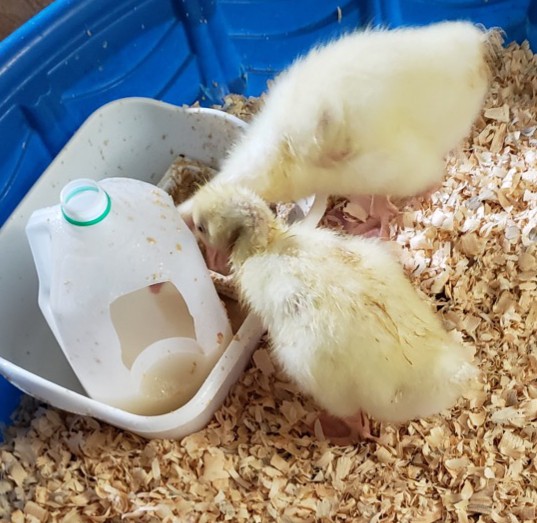
You already know that fermented food is good for people, but did you know that animals can benefit from it, too?
We’ve been fermenting feed for our fowl for a few years now. We like it for several reasons:
- Increased bioavailability of nutrients: soaking makes the nutrients in grains more available to the animals consuming it
- Probiotics: lacto-fermentation creates probiotics, which can boost the immune system and keep animals healthier (and it’s rumored to make their poop less smelly)
- Increased moisture: since the feed is wet, it’s easier for the waterfowl to eat, and it also helps keep all the fowl hydrated, especially in hot weather
- Less waste: since it’s not dry feed, scratchers like chickens aren’t able to kick it out of feeders, and even the smallest particles of feed are usable in fermented feed
- Better layer health = higher quality eggs: fermented feed has helped keep our flock healthy and happy, and along with their daily foraging, producing their delicious, nutritious eggs
While we can’t quantify it because we started fermenting feed very quickly after we acquired our first chickens, we believe that fermenting feed can help save money because it creates bulk via the soaking process and helps the animals feel full more quickly than dry feed (which takes a while to rehydrate after being eaten) – it’s similar to a person eating dry cereal versus cereal that’s soaked in milk.
Our method of fermenting feed is very simple. We use a non-GMO chick starter from our local feed mill as the base, and all of our animals eat the same feed because we have animals of both sexes, a variety of ages, and different species. Adults have access to free choice grit and oyster shell; young birds receive a sprinkling of the appropriately-sized grit on their meals (and nutritional yeast is sprinkled on the feed of young waterfowl for the niacin).
For the initial batch, we started by filling a food grade 5-gallon bucket about half full of dry feed. To increase the protein, we add about a cup of non-GMO dried distillers grains – also from the local feed mill and sourced from a local distillery (an advantage to living in bourbon country!). Add dechlorinated (this is important, as chlorine can inhibit the growth of lactic acid bacteria) water until the bucket is about 3/4 full. Stir well – the feed should have a soupy consistency similar to watery porridge – and cover loosely with a lid. For best results, keep in a room temperature area where it won’t get too warm or too cold.

It may take several days for the base fermentation to become active – you’ll know because the feed will smell pleasantly sour and you may see bubbles rising to the surface. Once it’s ready, feed to your fowl – find recommendations here for how much to feed: https://www.backyardchickens.com/threads/how-much-fermented-feed-per-bird.1211219/. It may take a few days (or none at all) for the transition to be successfully completed, but most birds will embrace it…from youngsters to adults. Keep some finished FF in the bucket after each feeding and use it as a fermentation starter for the next batch!

Drawbacks to fermenting feed? Just one comes to mind: the birds will be wearing it. Chickens will scratch it vigorously and ducks will fling it off their bills. A small price to pay for its benefits, I’d say.
Do you provide fermented feed to your fowl? Tell us about your experience in the comments!
